
BCG vs. Chemohyperthermia: Which Bladder Cancer Treatment is Right for You?
"A new study compares the effectiveness of BCG and chemohyperthermia for high-risk non-muscle-invasive bladder cancer. Find out which treatment shows more promise."
Bladder cancer is a major health concern, ranking as the fourth most common cancer among American men. The good news is that if caught early, when the cancer is non-muscle-invasive (NMIBC), the five-year survival rate is high. However, even with successful initial treatment, many patients face a risk of recurrence, making ongoing care essential.
After the initial tumor removal, patients with high-risk NMIBC often need additional treatments, called adjuvant therapies, to prevent the cancer from returning or progressing. Bacillus Calmette-Guérin (BCG), a type of immunotherapy, has long been a primary choice. However, because BCG can have significant side effects, researchers continue to explore new and improved options.
One such alternative is chemohyperthermia (C-HT), which combines chemotherapy with heat to target cancer cells. While several studies have suggested that C-HT could be beneficial, direct comparisons between BCG and C-HT have been lacking. Now, a new study sheds light on how these two treatments stack up against each other.
The Study: Comparing BCG and Chemohyperthermia

Researchers conducted a retrospective study to compare the effectiveness of BCG and C-HT in patients with high-risk NMIBC. The study included 1937 patients diagnosed with bladder cancer between January 2004 and January 2014. Of these, 710 patients received intravesical treatments (directly into the bladder), with some receiving C-HT and others receiving BCG.
- Patient Selection: The study focused on patients with high-risk NMIBC who underwent transurethral resection (TUR), a procedure to remove bladder tumors.
- Treatment Groups: Patients were treated with either intravesical C-HT or BCG instillation. The C-HT involved using a special unit to heat the bladder wall while administering chemotherapy. BCG was given weekly for six weeks.
- Follow-up: Patients underwent regular cystoscopies (bladder exams) and urine tests to monitor for recurrence.
- Statistical Analysis: The researchers used statistical methods to compare the recurrence-free intervals between the two treatment groups and to identify factors associated with recurrence and progression.
The Bottom Line: BCG Remains the Gold Standard, For Now
This study suggests that for patients with high-risk NMIBC who have not previously received BCG, BCG remains the more effective treatment option. While chemohyperthermia may offer an alternative for some patients, it did not perform as well as BCG in preventing cancer recurrence. However, it’s important to remember that this was a retrospective study, and more research is needed to confirm these findings. Future studies should also explore ways to improve chemohyperthermia or identify specific patients who might benefit most from this approach. If you have high-risk NMIBC, talk to your doctor about the best treatment plan for you.
